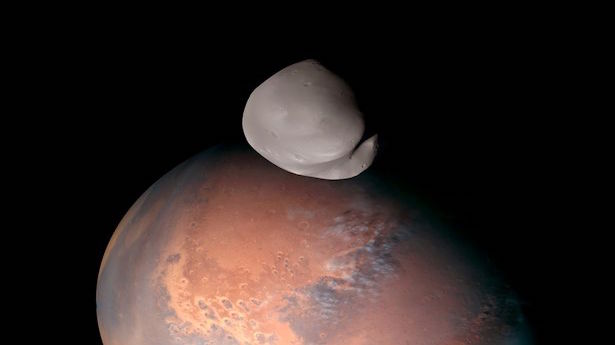Mars’ smaller moons have baffled a generation of scientists, but space researchers are ecstatic with the first pictures of Mars’ “most mysterious” moon from a new Arabian space mission. The United Arab Emirates has become the first Arab country to successfully launch a space mission to Mars, as it unveiled new groundbreaking observations of Mars’ smaller moon, Deimos, and its larger partner, Phobos. This sheds new light on the study of Mars’ moons and is challenging old theories about its origin.
New observations from the Emirates Mars Mission (EMM) challenge the long-held theory held by scientists that Martian moons are captured asteroids. Scientists involved with the mission now believe that the origin of Martian moons may actually come from the planet itself. They shared these observations on April 24 during the European Geosciences Union Congress in Vienna, the first successful space mission from an Arab country.
The Mars Hope rover captured it for the first time at a distance of 100 kilometers, the closest the spacecraft has come to Mars’ smaller moon since 1977.
Hessa Al Matroushi, head of science at EMM, said: “We are not sure about the origin of Phobos and Deimos. A long-standing theory is that they are captured asteroids, but there is little question about their composition. There are still unresolved questions. How exactly they got into their current orbit is also an active area of research, so any new information we get on these two moons, especially on the rarely observed Deimos It has the potential to open up a new understanding of the moons of Mars.”
While both of Mars’ moons were discovered in the 19th century, visual research was only possible during the space age. Deimos has been the most difficult moon to study because its wider orbit completes every 30 hours, meaning so little is known about it, it has been dubbed Mars’ “mystery moon.” The spacecraft will continue its series of flybys throughout 2023. For the rest of the year, the spacecraft will continue to fly past Mars.
Sarah Al Amiri, Chairperson of the UAE Space Agency, said: “The remarkable performance of the Mars Hope rover has supported a series of new observations, in addition to meeting our original stated science mission objectives.”
Kibo currently completes an orbit around Mars every 55 hours, capturing a full sample of planetary data every 9 days. It is a fully autonomous spacecraft carrying three instruments that measure the Martian atmosphere and weighs more than 1,350 kilograms.
